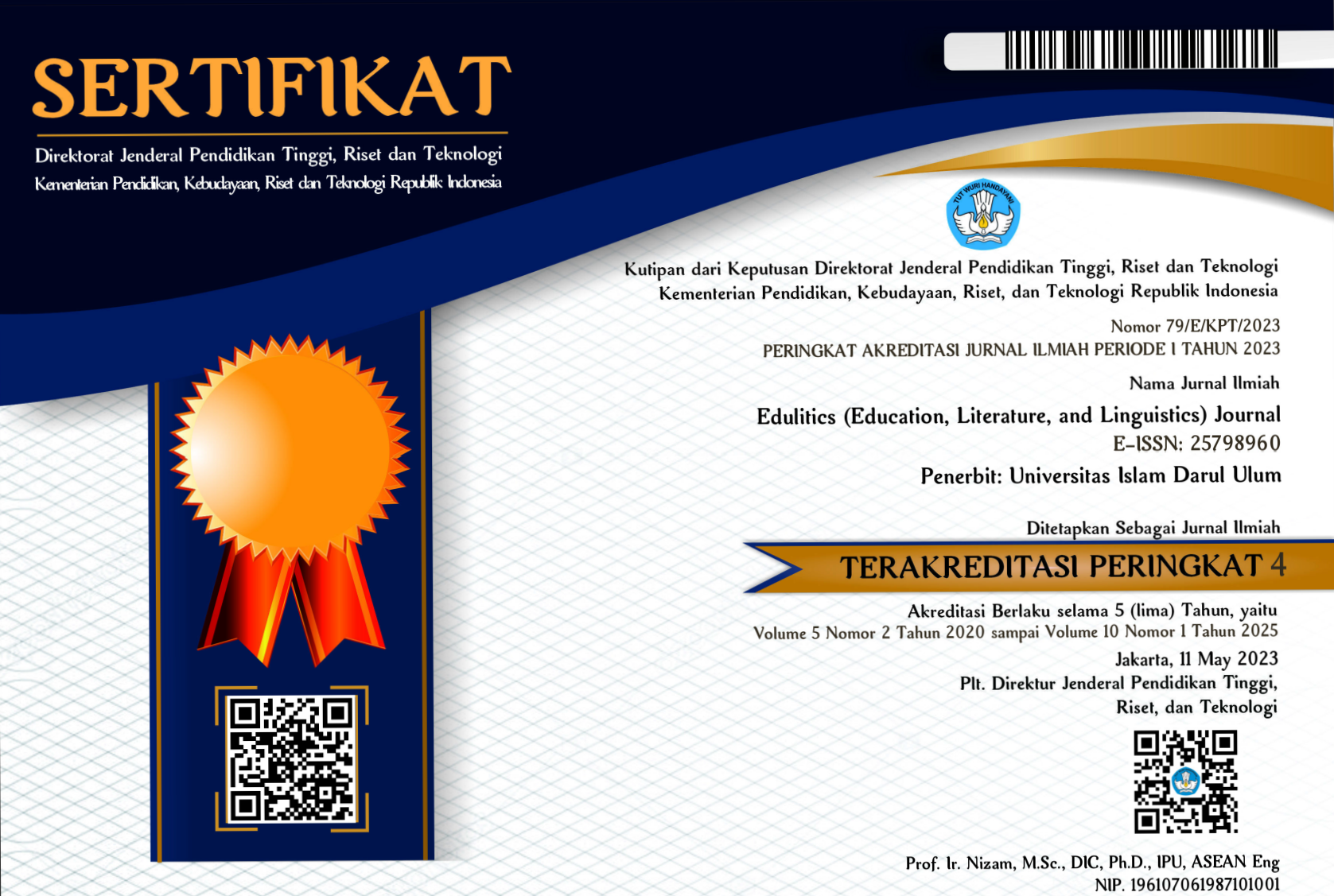| ACCREDITATION |
 |
Author Guidelines
- Author Guidelines
Authors are able to submit manuscripts to the journal directly through the journal's website by selecting the role as “Author” in the registration process. Start the submission process by logging in using the username and password that have been registered or the results being sent to the author's email. The Author is asked to upload a submission file and to provide metadata or indexing information. Follow the processing steps until the fifth step and click "finish submission". The final page provides a link to your Active Submissions, also immediately available upon entering OJS as an author.
The authors must refer to the Edulitics template for writing format and style (Please download the Edulitics template and use it as an initial manuscript template for submission). This will ensure a fast publication process. Any papers not fulfilling the requirements based on the guidelines to authors will be rejected.
Please be sure to check for spelling and grammar before submitting your paper. Anyone who has made independent contributions to the manuscript should be invited to become a co-author.
All articles must be submitted Online Submission at the e-journal portal (Open Journal System): where the author registers as an Author and/or is offered as a Reviewer by online. If authors have any problems with the online submission, please contact IT Support at the following email: edulitics@unisda.ac.id/ syifazahro@unisda.ac.id
Check the status of your manuscript periodically until published.
ATTENTION!
Authors should present their papers honestly without plagiarism or data manipulation. All authors must take public responsibility for the content of their papers.
Paper Preparation
Basic guidelines for preparing papers for the Edulitics are provided in this section. An example of the desired layout for papers is provided in the Microsoft Word template. Edulitics papers are limited from five to twelve pages at submission and written in English and all margins should be 2.54 cm with A4 for the size of the paper.
Parts of the Paper
The paper at least consists of the following section/item
Paper Title
The paper title should not be more than 16 words, in Times New Roman 12 pt font size, all in capitals, bold.
Author Line
The name of each author must appear on the paper written in Times New Roman 12 pt font size. Full names of authors are preferred in the author line. Do not use all uppercase for authors' surnames. Please write the number the author based on the order in superscript.
Affiliation Line
The affiliation of each author must also appear and be written in Times New Roman 12 pt font size. For foreign authors, please include the countries in the affiliations.
Email Address Line
Each of the author's emails is written and preferred using the institutional email address in Times New Roman 10 pt font size.
Abstract
An abstract must reflect the substance of the whole contents of the article and enable readers to determine relevance to their interest and decide whether or not to read the full document. The abstract consists of a statement about the background, objective or focus of the study, method or important research steps, findings, conclusion, and Implication. The abstracts are written in one paragraph, with single spacing, in Times New Roman font 10, and in total about 200-250 words, written in 10 in Times New Roman.
Keywords
It must be a maximum of 5 keywords written in 10 Times New Roman to help identify the major topics of the paper.
Introduction
This section should be written in Times New Roman 12 pt font size and contain background and research objectives that explain phenomena and research problems. It should also be related to previous studies, especially research gaps or limitations from previous studies. The author must fill the research gap/limitations, or the author must briefly explain the purpose of writing at the end of the Introduction. The Introduction is in the form of a narrative and does not use numbering.
Literature Review
This section must consist of the summary or analysis of all the research the author read before doing his/her own research. The author provides and describes the theoretical basis used and the background on who has done related research, what that research has or has not uncovered, and how the current research contributes to the discussion on the topic. This section also contains developments in the concepts or theories used. The literature used must be under the topic of the article being written. The author may divide this section into sub-headings.
Research Methods
This segment should be written in Times New Roman 12 pt font size and inform readers of the methods that the authors have used for the research. The Research Methodology includes the type of research, research design, population and sample, data collection techniques and instruments, measurement and operational definition of variables, and data analysis procedures. Please ensure that sufficient information has been given to allow for the repetition of the research
Findings and discussions
This section is written in Times New Roman 12 pt font size and contains the results of data analysis or statistical descriptions required. Tables/illustrations are placed in this section (at most six tables/illustrations) with a brief title. Authors can present an explanation/analysis of each table/illustration contained. Tables/illustrations that are more than one page in size can be placed in the Appendix.
The Discussion section is the author's interpretation of the research findings that can answer the limitations/research gaps of previous research and not repeat the research findings. The Discussion section includes how the research results related to the research objectives (what)? Do the authors provide a scientific interpretation of each finding presented (why)? Moreover, are the research results consistent or contradictory to the research results from other researchers (what else)? Sizes and styles of page setup are shown below. The example of the table and figure can be seen in the Article Template.
Conclusions
Please present the main conclusions of the study as the answer to the research objectives. The conclusions include a summary of the research, the contribution/implications of the study, the limitations of the study, and as far as possible, suggest potential areas for further research. The Conclusion section is written in a clear, concise, and does not re-quote previous research. In the form of a narrative, the conclusions presented do not use numbering and are not more than two paragraphs.
References
References are essential to the reader; therefore, each citation must be complete and correct. All reference results referred to in the article text must use primary references. We will usually expect a minimum of 20 to 30 references primarily to journal papers, depending on the length of the paper. The reference uses the APA Manual of Style 7th Edition Citations. Cite references in the text by name and year in parentheses. Authors are strongly urged to use a reference manager MENDELEY.
Samples of the correct formats for various types of references are given below.
Ali akbari, M., & Jamal vandi, B. (2010). The impact of role-play on fostering EFL learners' speaking ability: A task-based approach. Journal of the Pan-Pacific Association of Applied Linguistics, 14 (1), 15-29.
Badr, S. (2008). The effects of blended learning communicating on language apprehension and oral communication skills. Journal of Psychological and Educational Research, issued by Faculty of Education, Minufiyah University, 23 (1), 3-53.
Bahrani, T. (2011). Speaking fluency: Technology in EFL context or social interaction in ESL context. Studies in Literature and Language, 2 (2), 162-168.
Brown, HD (2001). Teaching by principles: An interactive approach to language pedagogy. San Francisco: Addison Wesley Longman, Inc.
Derwing, T., Muray, J.,& Thomson, RI (2008). A longitudinal study on ESL learners' fluency and comprehension development. Applied Linguistics, 29 (3), 359-380.
Friend, J., Adams, A., & Curry, G. (2011). Breaking news: Utilizing video simulations to improve educational leaders' public speaking skills. Journal of Research on Leadership Education, 6 (5), 234-249.
Sugiyono, 2015. Educational Research Methods, Bandung, Alfabeta.
Hartsell, T., & Yuen, S. (2006). Video streaming in online learning. AACE Journal, 14 (1), 31-43.
Murat, H. (2012). Turkish EFL word stress to learning English as a foreign language learners through internet-based video lessons. Retrieved from ERIC database. (ED 530678).
Romero, BN (2006). Improving speaking skills. Encuentro, 18, 86-90.
Tumova, M. (2002). Speaking activities aimed at developing fluency in EFL classes. MA Thesis, Faculty of Humanities, University of Pardubice, Czech Republic.
- Article's Template
The articles should be prepared according to the article's template provided by this journal.
- Reviewing of Articles
Every submitted paper is independently reviewed by at least two peer reviewers. The decision for publication, amendment, or rejection is based on their reports/recommendations. If two or more reviewers consider the articles unsuitable for publication in this journal, a statement explaining the basis for the decision will be sent to the authors within three months of the submission date.
- Revision Process
Articles sent back to the authors for revision should be returned to the editor without delay. Revised articles can be sent through the Online Submission Interface. The revised articles returned later than three months will be considered new submissions.
- Withdrawal of Articles
The authors are not allowed to withdraw submitted articles in the process of reviewing because the withdrawal is a waste of valuable resources that editors and reviewers spent a great deal of time processing submitted manuscripts. The withdrawal can be direct requests or without confirmation in which the authors do not send their revised articles. For this circumstance, the author and his/her affiliation will be blacklisted for publication in this journal.
- Plagiarism Check
The editors will run similarity checks using Turnitin, Grammarly, and Google to track the level of media text plagiarism.
- Article Submission and Processing Charges
Edulitics (Education, Literature, and Linguistics) Journal does not charge authors any fee for submitting, processing, and publishing articles. All processes of article publication are free of charge. Readers can read and download any full-text articles free of charge.
- User Rights
All articles published in Open Access will be immediately and permanently free for everyone to read and download. We are continuously working with our author communities to select the best choice of license options, currently being defined for this journal as follows: Creative Commons Attribution-Share-Alike (CC BY-SA) and accordance with the Budapest Open Access Initiative.





_(1).png)


